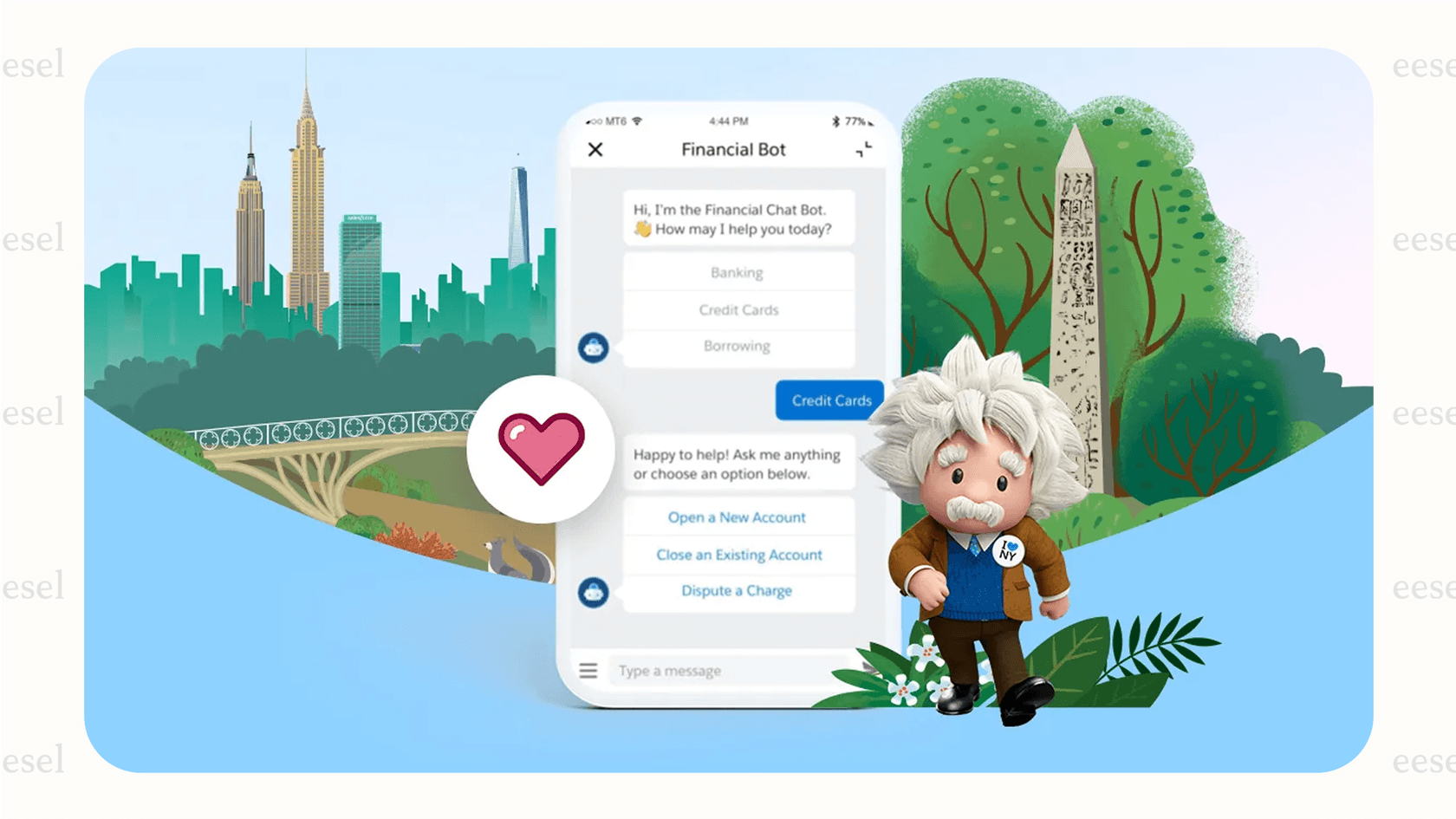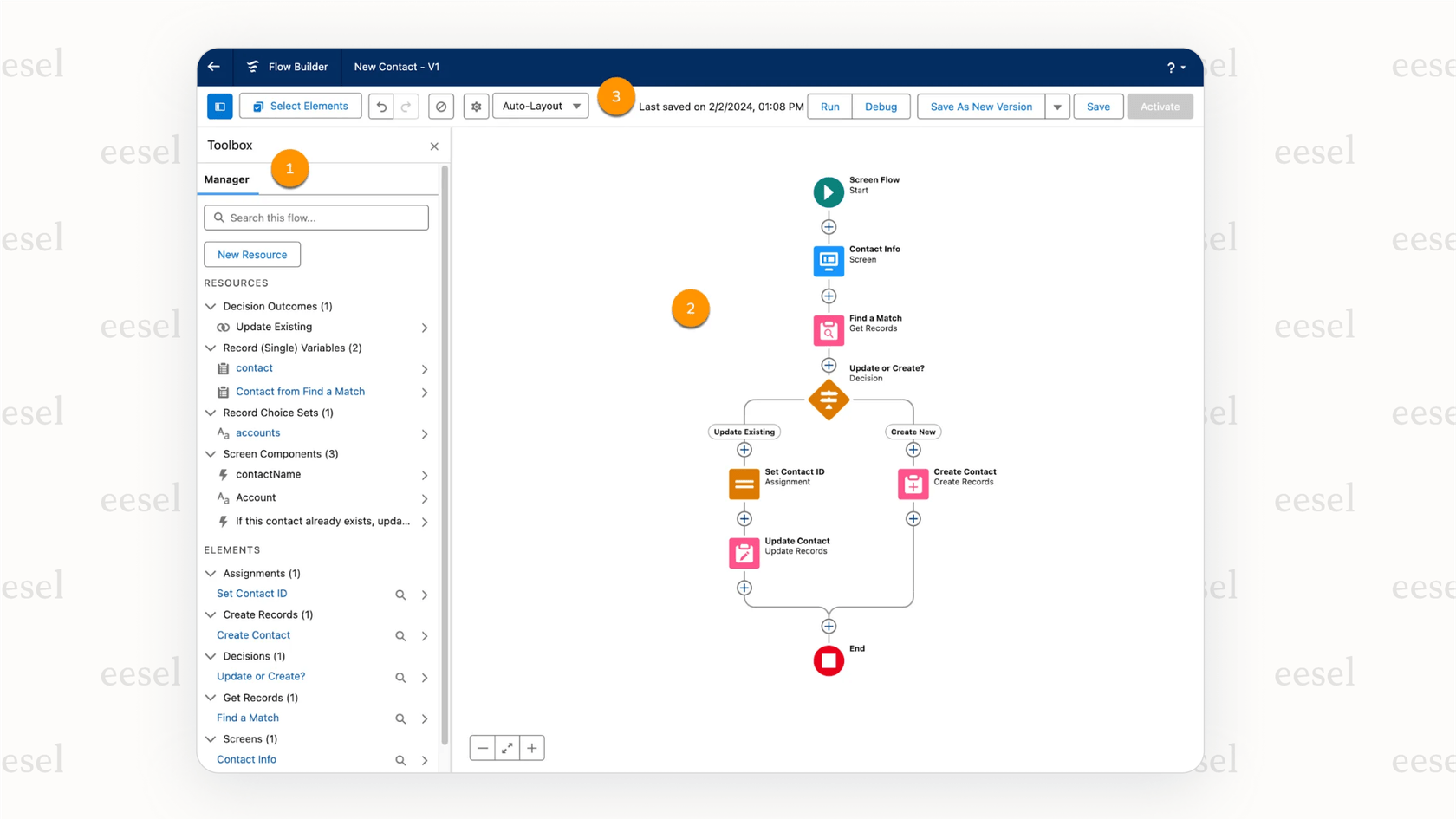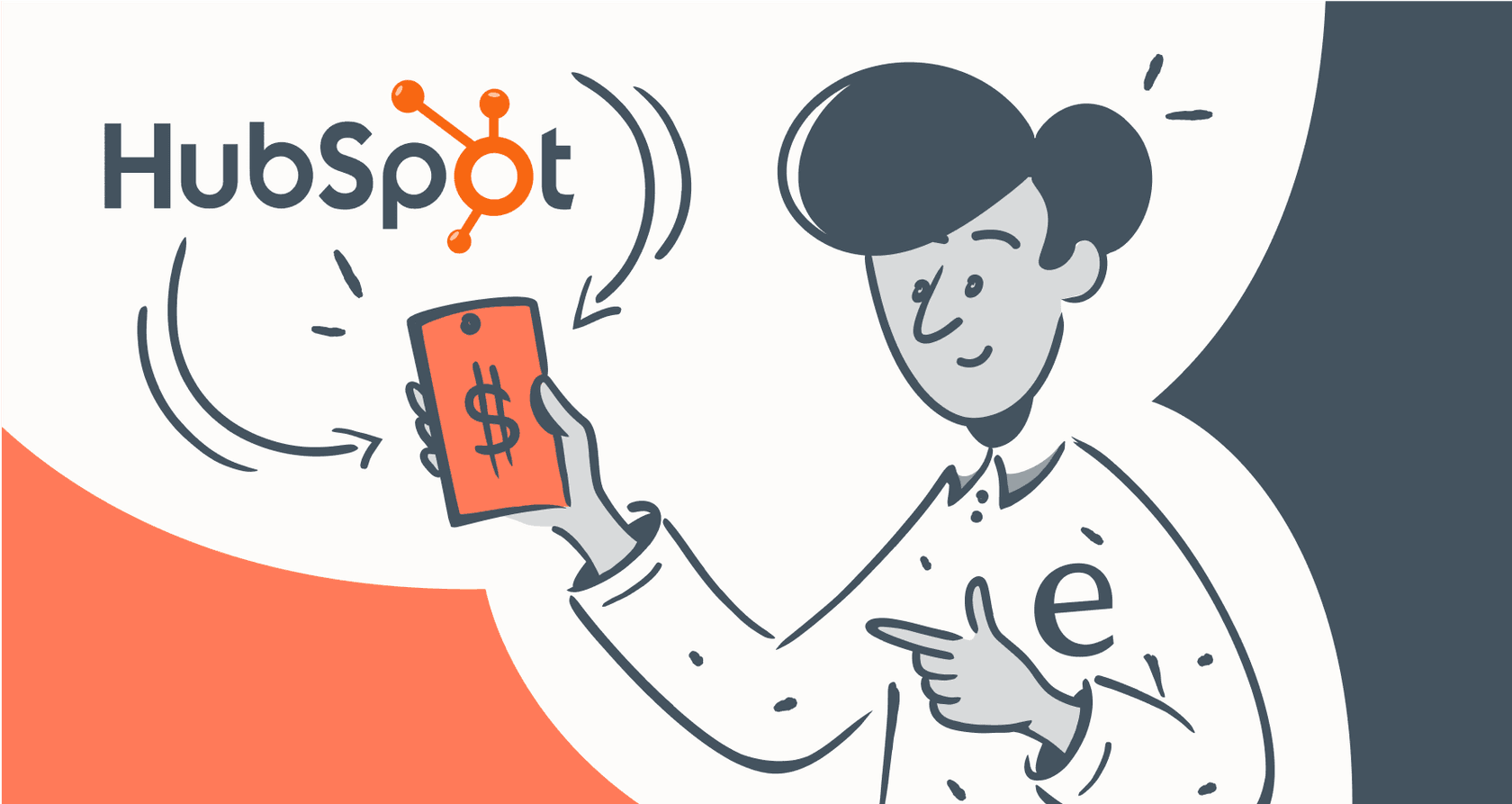
Let's be real, nobody likes waiting for customer support. Your customers want answers right away, not in a few hours or the next business day. This need for instant, 24/7 help has made AI chatbots pretty much essential, especially if your business runs on Salesforce.
But here’s the catch: while Salesforce offers its own chatbot, an actual Salesforce chatbot implementation can quickly become a complicated, expensive, and seriously time-consuming project.
This guide will give you an honest look at what it really takes to get Salesforce's native chatbot, Einstein Bots, up and running. We'll cover the setup, features, and pricing, and then show you a much simpler, more powerful way to get the job done.
What is a Salesforce chatbot?
Basically, a Salesforce chatbot is an AI tool that hooks into your CRM to handle customer chats, answer common questions, and take care of simple tasks automatically. The main one from Salesforce is called Einstein Bots. It’s part of the Service Cloud platform and uses Natural Language Processing (NLP) to figure out what customers are asking.
 A Salesforce Einstein Bot shown in a customer portal, demonstrating a key aspect of a Salesforce chatbot implementation.
A Salesforce Einstein Bot shown in a customer portal, demonstrating a key aspect of a Salesforce chatbot implementation.The goal is to field all those repetitive questions so your human agents can focus on the trickier stuff. Einstein Bots can pull data from your Salesforce records, create new support cases, and pass a conversation over to a live agent when it gets stuck.
But it’s not your only option. You can also use a third-party AI platform that connects to Salesforce. These tools usually offer a lot more flexibility, plug into way more data sources, and are much easier to set up.
The implementation process: What to expect
Salesforce has guided setup flows that make it look easy, but don't be fooled. A full implementation is a heavy lift with a lot of technical steps, which can be a huge hurdle for many teams.
Let's walk through the main stages and where things can get complicated.
Setting up the foundation: Chat, Omni-Channel, and permissions
Before you can even start building a bot, you have to get the groundwork ready inside Salesforce. This isn't just flipping a switch. You need to enable Salesforce Chat, set up Omni-Channel to route conversations to the right place, and then work your way through a maze of user permissions to grant the right agents access.
The tricky part is that this initial setup is a whole project on its own. It means clicking through dozens of screens in the Salesforce admin panel, and you’ll likely need a certified Salesforce administrator to pull it off. It’s a long way from a simple plug-and-play solution and can easily eat up days or weeks before you’ve written a single bot response.
Building the conversation: Dialogs, entities, and variables
Once the foundation is solid, you can start building your Einstein Bot. This means creating structured conversation flows (dialogs), telling the bot what kind of info to look for, like an email or order number (entities), and setting up little containers to store that info (variables).
 The Salesforce Flow Builder, a tool often required for a complex Salesforce chatbot implementation.
The Salesforce Flow Builder, a tool often required for a complex Salesforce chatbot implementation.The whole process can feel a bit clunky and rule-based. If you want your bot to do anything beyond basic FAQs, like checking an order status in an external system or updating a ticket, you'll find yourself needing deep knowledge of Salesforce Flow or even custom Apex code. This creates a huge dependency on developers and takes control away from the support managers who actually know the customer conversations inside and out.
A simpler alternative to a native implementation
This is where the complexity of a native Salesforce chatbot implementation becomes a real drag. Instead of getting stuck in technical weeds, you could be up and running in minutes. Tools like eesel AI were built to fix this exact problem.
Here’s what a simpler, self-serve setup looks like:
-
Actually self-serve: You can sign up, connect your tools, and launch your AI agent all on your own. No mandatory sales calls or long demos just to see if it’s a fit.
-
One-click connections: Forget wrestling with APIs and permissions. You can instantly connect to your helpdesk, like Zendesk or Freshdesk, and other tools you already use.
-
A powerful simulation mode: This is a huge one. With eesel AI, you can test your bot on thousands of your past support tickets before it ever talks to a real customer. You get a clear forecast of how well it will perform and how many issues it will resolve, so you can go live with confidence. Most native tools just don't offer this.
Core features and limitations
Einstein Bots are built to handle the usual stuff: answering FAQs, creating support cases, checking an order status, and handing chats off to human agents.
While that all sounds fine, the tool has some big limitations that can stop you from creating a truly helpful automated support system.
Knowledge sources: The Salesforce data silo
The biggest weakness of Einstein Bots is that they're designed to pull answers from knowledge stored inside Salesforce, like Salesforce Knowledge articles and CRM data. This is a massive problem because for most companies, important info is spread out all over the place, in Confluence, Google Docs, Notion, and internal Slack threads. If the answer isn’t in a Salesforce Knowledge article, your bot is probably going to come up empty.
This is a complete contrast to how a tool like eesel AI works. It connects to all your knowledge sources right away. It can learn from your help center, past tickets, internal wikis, and over 100 other apps, giving your AI the full picture so it can answer questions correctly, no matter where the information lives.
Customization and control: Rigid workflows vs. a flexible engine
Trying to customize an Einstein Bot can be a real headache if you’re not a developer. Changing the bot's personality, setting up detailed rules for when to escalate a ticket, or adding custom actions usually means diving back into Salesforce Flow or writing code.
eesel AI, on the other hand, gives you a fully customizable workflow engine without the technical mess. A simple prompt editor lets you define the AI's exact tone and personality. You can create specific rules for automation, deciding exactly which types of tickets the AI should touch. And with custom API actions, your bot can look up order details in Shopify or update other systems on the fly, all through an easy-to-use interface.
| Feature | Salesforce Einstein Bots | eesel AI |
|---|---|---|
| Knowledge Sources | Limited to Salesforce Knowledge & CRM data | Connects to Confluence, Google Docs, past tickets, & 100+ sources |
| Ease of Setup | Multi-day process, requires admin/dev help | Self-serve, go live in minutes |
| Custom Actions | Requires complex Flow or Apex code | Simple setup for custom API calls and actions |
| Simulation & Testing | Basic previewing | Powerful simulation on thousands of past tickets |
| AI Persona Control | Limited and rigid | Fully customizable via simple prompt editor |
This video provides a step-by-step guide to implementing Salesforce Einstein bots.
Understanding Salesforce chatbot implementation pricing
The cost of a Salesforce chatbot implementation is often tied up in expensive Service Cloud licenses. These are billed per user, per month, and you’re locked into an annual contract. It can get expensive, fast.
Here’s a rough breakdown based on Salesforce’s public pricing:
-
Enterprise Plan: This one starts at $175 per user/month, billed annually. Einstein Bots are often an add-on here, with some sources saying it costs an extra $75 per user/month.
-
Unlimited Plan: At $350 per user/month, billed annually, this plan usually includes Chat & Bots, but you're paying a lot for a bundle of features you might not even need.
-
Agentforce 1 Service: For the full AI suite, this plan starts at a whopping $550 per user/month, billed annually.
The issue with this pricing model is that it's expensive, hard to predict, and scales with your team size instead of the value you get. Hidden fees and long-term contracts lock you in before you even know if the bot is working for you.
eesel AI's pricing is refreshingly different:
-
Transparent & predictable: Plans are based on how many AI interactions you have, not pricey user seats. Your costs are tied directly to how much you use it.
-
No per-resolution fees: You’ll never get a surprise bill because you had a busy month. What you see is what you pay.
-
Flexible: With month-to-month plans you can cancel anytime, you’re not stuck in a long-term commitment. This lets you prove the value for yourself without the risk.
A smarter approach to your Salesforce chatbot implementation
While Salesforce offers a native chatbot, the Salesforce chatbot implementation is often way more complicated, costly, and limited than it seems. The tool is stuck with data inside Salesforce, needs developers for any real customization, and is locked behind an expensive, rigid pricing model.
Modern AI tools should make your team’s life easier, not create more technical work. Your AI should be able to learn from your entire knowledge base, not just one corner of it. For businesses that want a powerful, flexible, and affordable AI solution that works with Salesforce without all the friction, a tool like eesel AI is the way to go.
Ready to launch a powerful AI chatbot in minutes?
See how eesel AI connects to Salesforce and all your other knowledge sources to deliver instant, accurate support. Get started today and see what your support team can really do.
Frequently asked questions
A full native Salesforce chatbot implementation can be a multi-day or even multi-week project, requiring extensive setup of chat, Omni-Channel, and user permissions. This initial groundwork often demands the expertise of a certified Salesforce administrator.
A native Salesforce chatbot implementation often requires deep knowledge of Salesforce admin panels, Salesforce Flow, and potentially custom Apex code for advanced features. This can create a significant dependency on developers or certified Salesforce administrators.
The biggest limitation of a native Salesforce chatbot implementation is its reliance on data stored within Salesforce, such as Salesforce Knowledge articles and CRM data. It struggles to access information spread across external tools like Confluence or Google Docs.
The cost of a Salesforce chatbot implementation is usually tied to expensive Service Cloud licenses, billed per user/month annually. Einstein Bots are often an add-on or included in higher-tier plans, leading to significant, often unpredictable expenses.
Customizing a native Salesforce chatbot implementation beyond basic FAQs often involves complex Salesforce Flow configurations or writing custom code. This makes it less flexible for support managers to adjust the bot's personality or detailed escalation rules independently.
Yes, third-party AI platforms like eesel AI offer a much simpler Salesforce chatbot implementation, often self-serve and launchable in minutes. These alternatives provide greater flexibility, connect to diverse knowledge sources, and offer powerful testing capabilities.
Native Salesforce chatbot implementations offer basic previewing, but advanced testing is limited. Alternatives like eesel AI provide powerful simulation modes, allowing you to test your bot on thousands of past support tickets to forecast performance with confidence.






